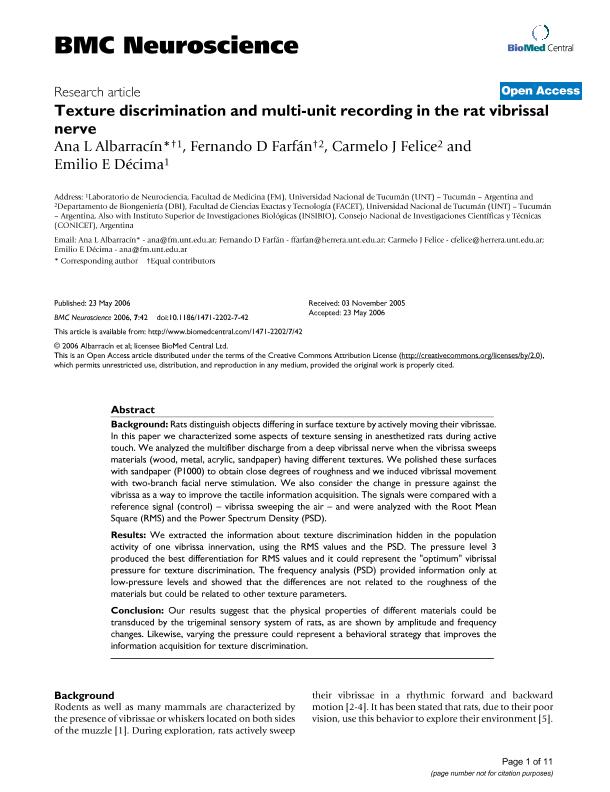Mostrar el registro sencillo del ítem
dc.contributor.author
Albarracin, Ana Lia

dc.contributor.author
Farfan, Fernando Daniel

dc.contributor.author
Felice, Carmelo Jose

dc.contributor.author
Décima, Emilio E.
dc.date.available
2020-01-20T20:53:28Z
dc.date.issued
2006-05
dc.identifier.citation
Albarracin, Ana Lia; Farfan, Fernando Daniel; Felice, Carmelo Jose; Décima, Emilio E.; Texture discrimination and multi-unit recording in the rat vibrissal nerve; BioMed Central; Bmc Neuroscience; 7; 5-2006; 1-11
dc.identifier.issn
1471-2202
dc.identifier.uri
http://hdl.handle.net/11336/95305
dc.description.abstract
Background: Rats distinguish objects differing in surface texture by actively moving their vibrissae. In this paper we characterized some aspects of texture sensing in anesthetized rats during active touch. We analyzed the multifiber discharge from a deep vibrissal nerve when the vibrissa sweeps materials (wood, metal, acrylic, sandpaper) having different textures. We polished these surfaces with sandpaper (P1000) to obtain close degrees of roughness and we induced vibrissal movement with two-branch facial nerve stimulation. We also consider the change in pressure against the vibrissa as a way to improve the tactile information acquisition. The signals were compared with a reference signal (control) - vibrissa sweeping the air - and were analyzed with the Root Mean Square (RMS) and the Power Spectrum Density (PSD). Results: We extracted the information about texture discrimination hidden in the population activity of one vibrissa innervation, using the RMS values and the PSD. The pressure level 3 produced the best differentiation for RMS values and it could represent the "optimum" vibrissal pressure for texture discrimination. The frequency analysis (PSD) provided information only at low-pressure levels and showed that the differences are not related to the roughness of the materials but could be related to other texture parameters. Conclusion: Our results suggest that the physical properties of different materials could be transduced by the trigeminal sensory system of rats, as are shown by amplitude and frequency changes. Likewise, varying the pressure could represent a behavioral strategy that improves the information acquisition for texture discrimination.
dc.format
application/pdf
dc.language.iso
eng
dc.publisher
BioMed Central

dc.rights
info:eu-repo/semantics/openAccess
dc.rights.uri
https://creativecommons.org/licenses/by/2.5/ar/
dc.subject
Vibrissa
dc.subject
Surface Texture
dc.subject
Discrimination
dc.subject.classification
Otras Ciencias Biológicas

dc.subject.classification
Ciencias Biológicas

dc.subject.classification
CIENCIAS NATURALES Y EXACTAS

dc.title
Texture discrimination and multi-unit recording in the rat vibrissal nerve
dc.type
info:eu-repo/semantics/article
dc.type
info:ar-repo/semantics/artículo
dc.type
info:eu-repo/semantics/publishedVersion
dc.date.updated
2019-05-27T17:04:28Z
dc.journal.volume
7
dc.journal.pagination
1-11
dc.journal.pais
Reino Unido

dc.journal.ciudad
Londres
dc.description.fil
Fil: Albarracin, Ana Lia. Consejo Nacional de Investigaciones Científicas y Técnicas. Centro Científico Tecnológico Conicet - Tucumán. Instituto Superior de Investigaciones Biológicas. Universidad Nacional de Tucumán. Instituto Superior de Investigaciones Biológicas; Argentina. Universidad Nacional de Tucuman. Facultad de Medicina. Departamento de Investigación. Cátedra de Neurociencia; Argentina
dc.description.fil
Fil: Farfan, Fernando Daniel. Consejo Nacional de Investigaciones Científicas y Técnicas. Centro Científico Tecnológico Conicet - Tucumán. Instituto Superior de Investigaciones Biológicas. Universidad Nacional de Tucumán. Instituto Superior de Investigaciones Biológicas; Argentina. Universidad Nacional de Tucumán. Facultad de Ciencias Exactas y Tecnología. Departamento de Bioingeniería; Argentina
dc.description.fil
Fil: Felice, Carmelo Jose. Universidad Nacional de Tucumán. Facultad de Ciencias Exactas y Tecnología. Departamento de Bioingeniería; Argentina. Consejo Nacional de Investigaciones Científicas y Técnicas. Centro Científico Tecnológico Conicet - Tucumán. Instituto Superior de Investigaciones Biológicas. Universidad Nacional de Tucumán. Instituto Superior de Investigaciones Biológicas; Argentina
dc.description.fil
Fil: Décima, Emilio E.. Universidad Nacional de Tucuman. Facultad de Medicina. Departamento de Investigación. Cátedra de Neurociencia; Argentina
dc.journal.title
Bmc Neuroscience

dc.relation.alternativeid
info:eu-repo/semantics/altIdentifier/url/http://www.biomedcentral.com/1471-2202/7/42
dc.relation.alternativeid
info:eu-repo/semantics/altIdentifier/doi/https://doi.org/10.1186/1471-2202-7-42
Archivos asociados
